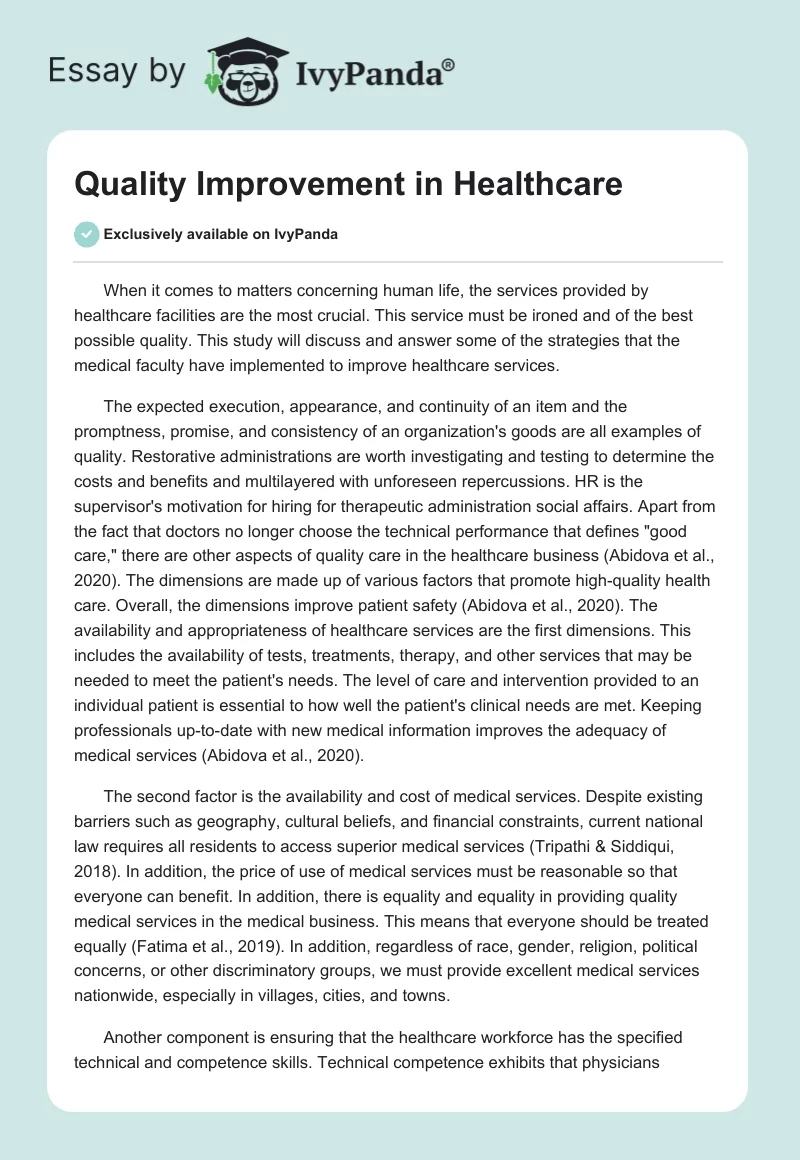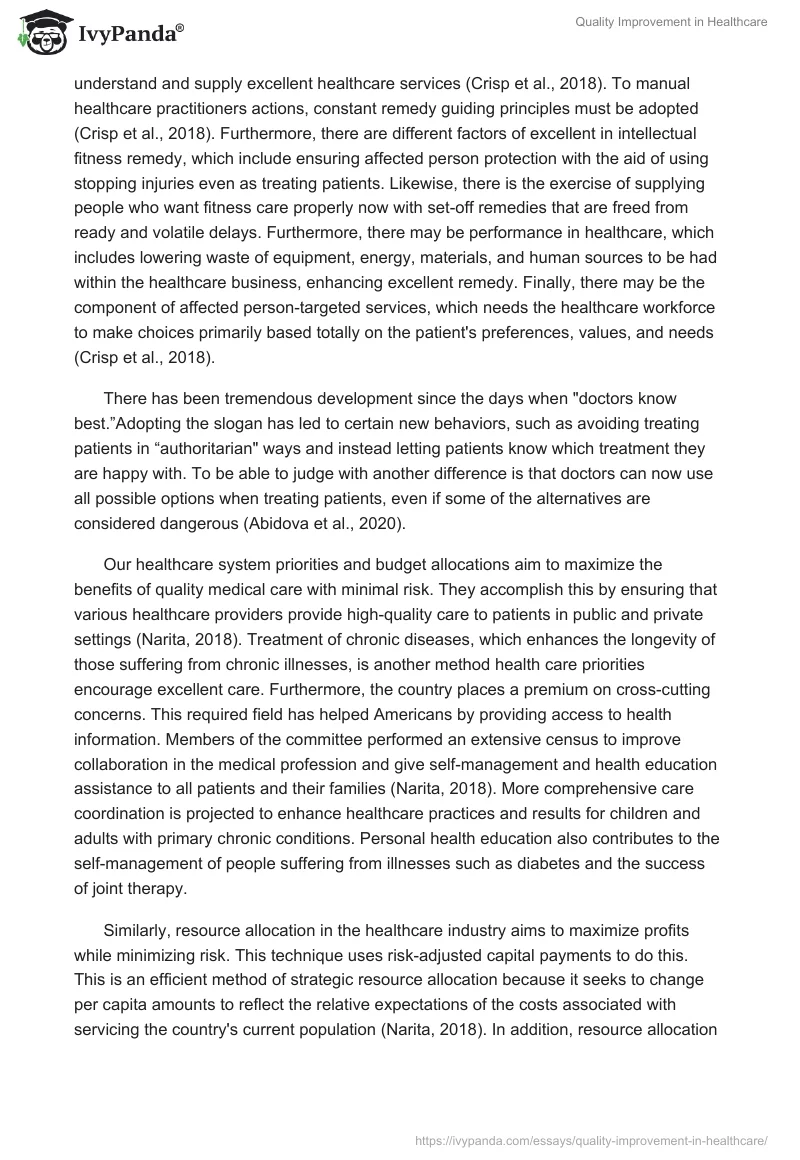When it comes to matters concerning human life, the services provided by healthcare facilities are the most crucial. This service must be ironed and of the best possible quality. This study will discuss and answer some of the strategies that the medical faculty have implemented to improve healthcare services.
The expected execution, appearance, and continuity of an item and the promptness, promise, and consistency of an organization’s goods are all examples of quality. Restorative administrations are worth investigating and testing to determine the costs and benefits and multilayered with unforeseen repercussions. HR is the supervisor’s motivation for hiring for therapeutic administration social affairs. Apart from the fact that doctors no longer choose the technical performance that defines “good care,” there are other aspects of quality care in the healthcare business (Abidova et al., 2020). The dimensions are made up of various factors that promote high-quality health care. Overall, the dimensions improve patient safety (Abidova et al., 2020). The availability and appropriateness of healthcare services are the first dimensions. This includes the availability of tests, treatments, therapy, and other services that may be needed to meet the patient’s needs. The level of care and intervention provided to an individual patient is essential to how well the patient’s clinical needs are met. Keeping professionals up-to-date with new medical information improves the adequacy of medical services (Abidova et al., 2020).
The second factor is the availability and cost of medical services. Despite existing barriers such as geography, cultural beliefs, and financial constraints, current national law requires all residents to access superior medical services (Tripathi & Siddiqui, 2018). In addition, the price of use of medical services must be reasonable so that everyone can benefit. In addition, there is equality and equality in providing quality medical services in the medical business. This means that everyone should be treated equally (Fatima et al., 2019). In addition, regardless of race, gender, religion, political concerns, or other discriminatory groups, we must provide excellent medical services nationwide, especially in villages, cities, and towns.
Another component is ensuring that the healthcare workforce has the specified technical and competence skills. Technical competence exhibits that physicians understand and supply excellent healthcare services (Crisp et al., 2018). To manual healthcare practitioners actions, constant remedy guiding principles must be adopted (Crisp et al., 2018). Furthermore, there are different factors of excellent in intellectual fitness remedy, which include ensuring affected person protection with the aid of using stopping injuries even as treating patients. Likewise, there is the exercise of supplying people who want fitness care properly now with set-off remedies that are freed from ready and volatile delays. Furthermore, there may be performance in healthcare, which includes lowering waste of equipment, energy, materials, and human sources to be had within the healthcare business, enhancing excellent remedy. Finally, there may be the component of affected person-targeted services, which needs the healthcare workforce to make choices primarily based totally on the patient’s preferences, values, and needs (Crisp et al., 2018).
There has been tremendous development since the days when “doctors know best.”Adopting the slogan has led to certain new behaviors, such as avoiding treating patients in “authoritarian” ways and instead letting patients know which treatment they are happy with. To be able to judge with another difference is that doctors can now use all possible options when treating patients, even if some of the alternatives are considered dangerous (Abidova et al., 2020).
Our healthcare system priorities and budget allocations aim to maximize the benefits of quality medical care with minimal risk. They accomplish this by ensuring that various healthcare providers provide high-quality care to patients in public and private settings (Narita, 2018). Treatment of chronic diseases, which enhances the longevity of those suffering from chronic illnesses, is another method health care priorities encourage excellent care. Furthermore, the country places a premium on cross-cutting concerns. This required field has helped Americans by providing access to health information. Members of the committee performed an extensive census to improve collaboration in the medical profession and give self-management and health education assistance to all patients and their families (Narita, 2018). More comprehensive care coordination is projected to enhance healthcare practices and results for children and adults with primary chronic conditions. Personal health education also contributes to the self-management of people suffering from illnesses such as diabetes and the success of joint therapy.
Similarly, resource allocation in the healthcare industry aims to maximize profits while minimizing risk. This technique uses risk-adjusted capital payments to do this. This is an efficient method of strategic resource allocation because it seeks to change per capita amounts to reflect the relative expectations of the costs associated with servicing the country’s current population (Narita, 2018). In addition, resource allocation aims to provide payments that reduce the risk of certain illnesses and reduce the likelihood of individual death.
Both implicit standards and explicit criteria are used to assess the quality of medical care. The two criteria differ in that the implicit criteria are mostly used in cases with precise characteristics, allowing the highly individualized assessment to be remembered as high quality, whereas the explicit criteria in healthcare assessment are not widely used because they are costly to develop, but they can be used to produce precise assessments (Njong & Tchouapi, 2021). However, evaluation is performed only if explicit reference availability is assigned. Exact criteria have, for example, an advantage in an analysis of the resulting determination leading to subjective maneuvering. In addition, there may be an answer suitable for bending and elementary schools in the hospital. In addition, clear criteria provide essential and efficient screening tools to help identify patients at high risk for quality of care problems. Nurses use explicit criteria to perform specific clinical observations and tests. Implicit criteria are not commonly used but are a well-structured approach to assessing health care quality.
References
Abidova, A., Alcantara da Silva, P., & Moreira, S. (2020). Predictors of Patient Satisfaction and the Perceived Quality of Healthcare in an Emergency Department in Portugal.WestJet 21.2 March Issue, 21(2), 391–403. Web.
Ashton, C., Kuykendall, D., Johnson, M., & Wray, N. (2018). An Empirical Assessment of the Validity of Explicit and Implicit Process-of-Care Criteria for Quality Assessment. Medical Care, 37(8), 798-808.
Crisp, N., Brownie, S., & Refsum, C. (2018). Nursing & Midwifery: The key to the rapid and cost-effective expansion of high-quality universal healthcare. Doha, Qatar, World Innovation Summit for Health, 1–39. Web.
Fatima, I., Humayun, A., Iqbal, U., & Shafiq, M. (2019). Dimensions of service quality in healthcare: a systematic review of the literature.International Journal for Quality in Health Care, 31(1), 11–29. Web.
Narita, Y. (2018). Efficient Resource Allocation based on Priorities: A Comment. SSRN Electronic Journal.
Njong, A. M., & Tchouapi, R. P. M. (2021). Assessing User Satisfaction with the Quality of Healthcare Services in Cameroon. In publication.aercafricalibrary.org. AERC. Web.
Tripathi, S. N., & Siddiqui, M. H. (2018). Assessing the quality of healthcare services: A SERVQUAL approach.International Journal of Healthcare Management, 1–12. Web.


